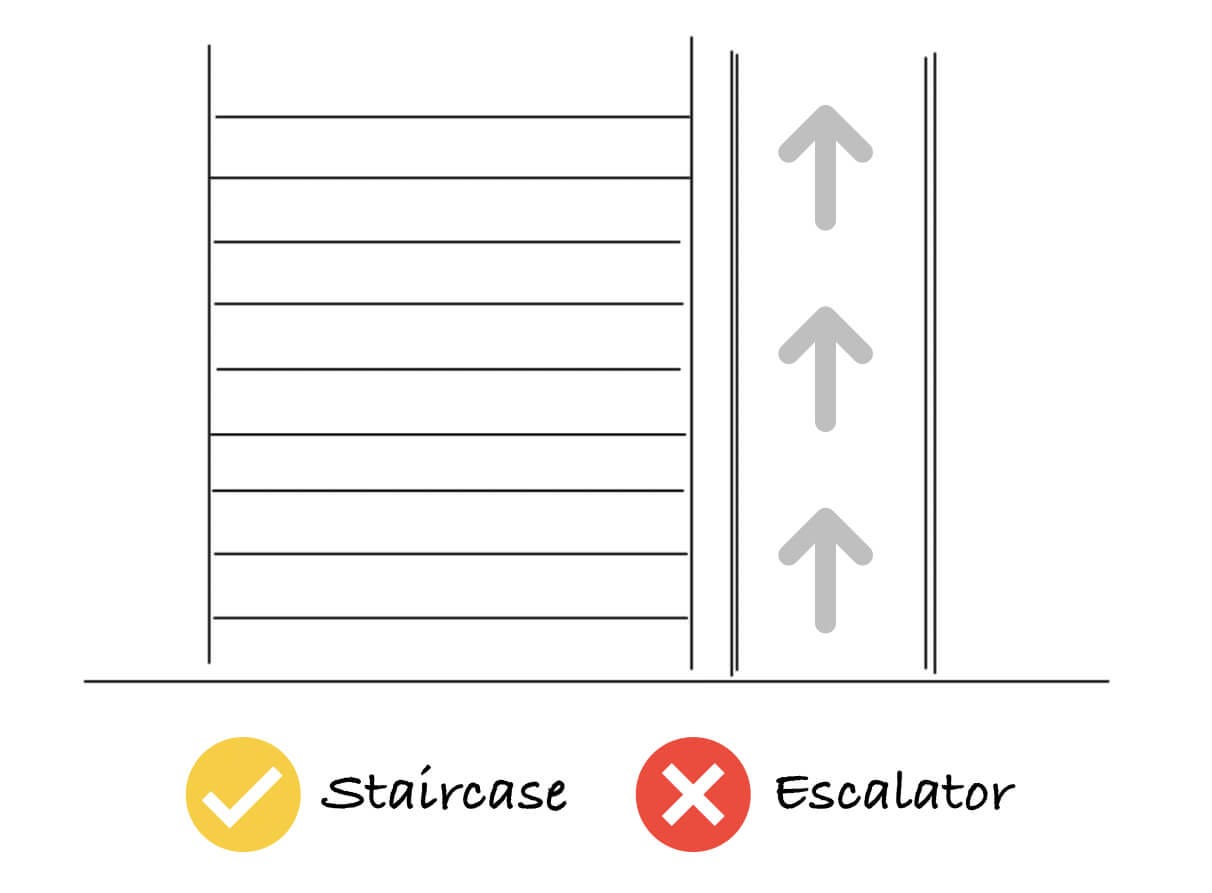The Staircase-Escalator Problem
What I saw after getting off a train ride.
The last time I wrote something like this was in 2020 (published in 2022). Back then, I was doing my dishes when I saw four construction workers carrying a long rod. It somehow inspired me to talk about leadership. Surprised? I felt the same way too.
In hindsight, I noticed how ideas like this come only when you’re being mindful. When you don’t think about anything other than the present. When you just let your gaze wander into the physical distance yet unlike a thousand-yard stare into nothingness.
Last Sunday was one such day.
🚶To “staircase” or not
Chinese (Lunar) New Year was over. The holidays, that is. I was traveling back to the university to resume the semester. It was a long train ride with ~300 passengers, the bulk of which would get off at the final stop — the central station where all transit lines connect.
It was underground.
To get to the ground floor where the exit ticket gates are, we could take either the stairs, the escalator, or the elevator. Typically, elevators are reserved for people with special needs. That’s reasonable. Hence it left us with either the stairs or the escalator — if you think about it, the latter is also a flight of stairs, but moving.
Most people would prefer the escalator because it’s the most convenient option. Just stand still and let the engineering magic do its thing. It’s the more obvious choice if you’re carrying heavy luggage.
Minimal effort. Maximum comfort.
But there is always a tiny group of people who like stairs. Oftentimes the reason cited is health, while some prefer going up quickly rather than having to wait in line.
As one of them, I was looking forward to it.
But…
🤯Something blew my mind
The stairs were sealed off.
The only way up was to wait in line for a single escalator. Crowd control was in place such that you could only go up in batches. Remember, the bulk of the train — assuming 200 people — got off here. Imagine the line.
I was confused.
Why bother sealing the stairs? They look fine. No hazard as far as one could tell. Is it just an “admin” mistake? Like being engrossed with getting something done that you end up not thinking and just picking the most inefficient way to do it?
Up the floor, I asked an officer-in-charge what the flying flamingo was going on. Paraphrasing what he said,
Yes, it’s for crowd control. If we didn’t limit the way up and before the limited exit ticket gates upstairs, 300 people would get suck on the escalator.
Don’t forget that thing is moving.
*realized*
“OOOOOOOOOOHHHHHHHHHHH”
Now that was one misunderstanding cleared up. I could imagine a few people getting grumpy and blaming — in their hearts — the authorities for the waiting time, while they were just trying to save their asses from falling like dominoes down the escalator. If that happened, it would escalate quickly (#punintended) and the authorities would be blamed for not carrying out their duties.
What a tough job.
❎But was it the best way?
Was limiting 200 passengers to a single escalator the best solution?
I remembered a concept from my “beloved” chemical engineering (CE) course at university — process scheduling.
It means scheduling multiple processes — carrying a few at the same time or overlapping parts of them — to maximize productivity (hence, profit). It is similar to “batching” in the world of productivity where Ali Abdaal and Matt D’Avella live.
What if we use that here?
What if we maximize productivity — the number of passengers going upstairs per unit time, leading to lower waiting time and higher satisfaction — without compromising on safety?
Getting on (yet) another train ride, I thought about this.
☝️Case 1: Free for all
Both the stairs and the escalator are open. Passengers are free to choose which they want to use. This is the choice the authorities avoided in the first place. But what was wrong with it?
In the world of habit building, there’s something called the Law of Least Effort.
We will naturally gravitate toward the option that requires the least amount of work.
—James Clear, Atomic Habits
Between stairs and an escalator, you will naturally pick the more comfortable option that takes a lower amount of energy to reach the same goal. Of course, there’ll be odd ones who enjoy taking the stairs. For simplicity, let’s assume:
Number of people going up: 200
Number of people taking the stairs: 40 (20%)
Number of people taking the escalator: 160 (80%)
I’m not an escalator specialist, but I’m pretty sure you can’t fit 160 people on a standard escalator at a time. Hence,
Number of people on 1 step: 2 side-by-side
Height between floors: 4 meters
Riser (height of step portion you see): 0.2 meter
Total number of stand-able steps: 4/0.2 = 20
Max. number of people using at a time: 20 x 2 = 40
Adjusted max. considering luggage: 30 people
In other words, 2 rows of 30 people altogether (with luggage) can go up a time, while the rest must wait in line for the next batches.
Oh, wait. Don’t forget there are limited exit gates.
Number of exit gates: 4
Estimated duration to pass through one: 10 seconds
The first 4 people will arrive and take 10 seconds to pass approximately at the same time. The waiting time for the next 4 can be reduced by the time to (a) go up the escalator, (b) get off it, and (c) walk towards the exit gates. It means that when the next 4 reach the gates, they just need to wait a little before their turn.
This is just a rough analysis. The point is that there’s an ideal scheduling with minimal waiting time at the exit gates and a low risk of the “escalator dominoes”.
That also means the time between batches going up is minimal. Hence, people wait less for the escalator.
Even if the waiting time is significant, the dissatisfaction can be mitigated with the offer of the staircase, unlike in the actual case where it was sealed.
What could go wrong?
Don’t forget the “disturbance” — 40 staircase people.
The number is notable enough to prolong the wait at the ticket gate and break apart the ideal scheduling we talked about. And what if there are more people? Because it is a free-for-all, you can’t be sure.
10 seconds at the gates.
30 people up the escalator.
40 people taking the staircase.
These are some assumptions we made just now. You cannot base safety on uncertainties and assumptions.
That’s likely why the authorities did what they did, even if the cost was inconvenient due to longer waiting time.
✌️Case 2: Controlled staircase only
What if you switch it? What if you close the escalator and direct the ascent up the staircase in batches?
The result? You’re just going to make everyone hate you more.
Consider this:
Waiting + using the escalator
Waiting + using the stairs
By the Law of Least Effort, which path takes the least effort?
Option 2.
In this case, you are asking everyone to take the harder path. Even if more people can fit the staircase at a time — hence less overall waiting time, you’re just going to piss many people off by forcing them to take the stairs.
👌Case 3: Controlled staircase & escalator
In the actual case, one officer controlled the size of each batch — the number of people going up the escalator at a time. At the top, another officer would signal his buddy to let the next batch up when the current batch was almost done exiting the ticket gates.
What if we do the same thing for the staircase too? Does having more space to go up reduce the waiting time?
I thought this would be the best way. But it likely wouldn’t be.
The problem is at the exit gates
More specifically, the limited number. 4, if I’m not mistaken.
Even if more people could go up at a time, they would still be limited by how many could pass through the gates at a time, and how fast. In other words, there is an optimum number of how many people could go up — staircase, escalator, or both — without overloading the exit gates.
Me: Oh! Oh! Didn’t we assume only 30 people can go up the escalator at a time? What if the optimum is more than 30? Won’t opening the staircase help to supplement the number?
Also me: If that’s the case, why don’t just increase the size of each escalator batch? Instead of the pain of taking the stairs, you allow more people to enjoy the escalator comfort.
Even if you fix the escalator batch size at 30, the number supplemented by the staircase batch won’t be helpful. Because the optimum number is likely not far from 30. Maybe 35 is the optimum, so the staircase only supplements 5. You may need extra manpower — cost — for crowd control for a small improvement.
🏡Afterthought
Phew, that was intense. I even missed my commuter’s stop when writing this. Ouch.
Editing this essay reminded me to live in the present. Because worrying about things while doing something else — like walking, eating, having fun, etc. — is just gonna make life more stressful and less enjoyable. And good ideas won’t come easily, too.
—Thomas🦙
🏆 Weekly Gold
Each week, I share something I found interesting with you. It could be a song, a book, a quote, or a video that blew my mind. Here’s the gold this week 👇
Feeling a little overwhelmed recently. Then I realized that I hadn’t been listening to music that often lately. Feels good to do it again :3
🔗 Other Credits
The officer who explained why it happened when asked.
KONE’s planning guide for escalators and auto-walks.








